 |
| This actually exists. |
That being said, before Japan collectively stopped taking their medication, they created some really awesome stuff... swords, aikido, pottery, and sake (pronounced SAH-kay, not SOCK-ee) to name a few. I'd also like to note that the preceding paragraph is going to lead to some very disappointing Google searches.
The History of Sake or How to Make Booze out of ANYTHING!
Trying to date sake is like trying to date water. It's been around for as long as anyone can remember. The earliest written record of the drink was penned sometime in the 3rd century, which predates the fucking compass. The Japanese had been drinking sake for more than a thousand years by the time word that such a thing even existed reached the western hemisphere in the 18th century.
Sake production was solely the job of the government until the 10th century, when (who else but) monks started brewing it. They held the job for around 500 years, until average schmucks were finally allowed to open breweries in the late 1800s. Sake remained extremely popular in Japan until World War II, at one point making up a full 30% of national tax revenue. Rice rationing during the war really put a damper on sake production, which would never return to its former glory thanks to all the new, foreign booze pouring in.
What the Fuck is Sake?
It's fermented rice, water, and yeast. Though often referred to as "rice wine", sake is actually brewed much like beer. Master sake brewers are called tōji, which is a very highly respected position in Japanese society. The production of sake is at MacGyver-levels of complexity, which is understandable since rice doesn't actually contain the necessary elements needed to create alcohol all on its own.
 |
| Meroni |
To make sake, the rice is polished (more on that later), soaked in water, then boiled or steamed. A part of this now soft rice is combined with a fungus called kōji and cultivated for a few days. Then, it's mixed with water, yeast, and fresh steamed rice and left to cultivate again, producing a starter mash. They repeat this process several times, each time mixing the new mash with the old mash until they have what is called the main mash, or meroni. The meroni is then fermented multiple times, which converts the starch from the rice into glucose, which is in turn turned into alcohol by the yeast. Once the fermentation is finished, some distilled alcohol is usually added to the mixture (which helps extract certain flavors from the mash in small doses, or, in large doses, used to add alcohol to a shitty product) and it's pressed to extract the sake.Then MacGyver makes a hang-glider out of an old poster and some PVC pipe and soars to safety with some random-yet-hot 80s chick.
What the Fuck does Sake Taste Like?
Drinking sake is almost like drinking slightly thick, flavored water. You'll find many types have surprisingly fruity tastes (melons, citrus fruits, even kiwi) though earth notes are pretty well represented as well. The great thing about sake as aftertaste: there isn't one. Sake has a very clean finish without the tannins and sulfates you get from other beverages, meaning your mouth stays feeling very clean.
Sake can be dry or sweet. This is noted by a plus or minus number located somewhere on the bottle. A plus sign indicates sweetness; the higher the number, the sweeter the sake. The opposite goes for minus. Average sake comes in at around a +1 or +2, which is semi-dry.
You'll also see undiluted, or nigori sake. This is sake from which all of the grain residue has been removed, but not carbon filtered, lending it an extremely sweet taste.
Types of Sake
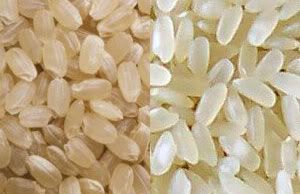 |
| Unpolished v.s. Polished |
Polishing, or milling, removes the outer layer of the rice and, with it, undesirable proteins and oils. The amount of polishing determines the type of sake. It also determines the price, because polishing rice isn't the easiest thing in the world to do. Typically, about 30% of the rice is polished away, but certain premium sakes will discard up to 80%, giving you the "soul of the rice". Keep in mind that, after a certain amount of polishing, this may or may not be complete bullshit.
You're most likely to encounter sake at a sushi restaurant. There, you'll probably find these three categories:
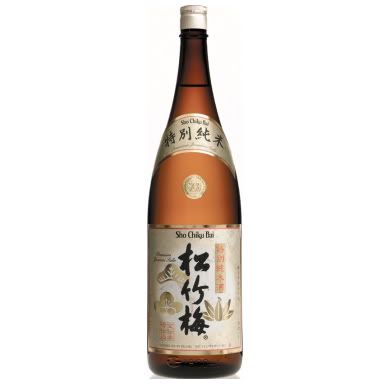 Junmai (june-MY)
Junmai (june-MY)On one side of the coin, we have junmai sake, which I like to refer to as "sake with balls". Rice used in junmai sake is polished the least (abut 70% of the rice remains) so it has a big, bold flavor.
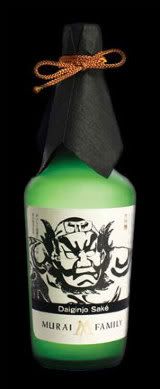
Daiginjo (die-GEN-joe)
On the other hand, daiginjo sake is extremely delicate. It's rice is polished the most (at least 50%), so you're dealing with very subtle nuances of flavor that are easy to lose in a meal. It has carries a heavier price tag, but is really great before a meal.
Ginjo (GEN-joe)
Ginjo sake is best described as extremely straightforward. It has a very even, crisp taste that works very well with food. It's not so complex that it'll be lost in your California roll, but not so overpowering that it takes over your mouth.
Drinking Sake
 Even if you know nothing at all about sake, you're probably familiar with what it's served in: the little ceramic pitcher and tiny glasses. These are traditional, but not surprisingly, not all that great for drinking (much like coupe glasses are shitty for drinking champagne). While not produced like wine, sake has many of the same qualities as wine, and the ideal glassware is pretty much the same. A brandy snifter or basic wine glass is best. Whatever you do, don't drink your sake out of a little wooden box, which is also traditional. Not only does it make a huge mess, but the wood fucks with the taste of your drink.
Even if you know nothing at all about sake, you're probably familiar with what it's served in: the little ceramic pitcher and tiny glasses. These are traditional, but not surprisingly, not all that great for drinking (much like coupe glasses are shitty for drinking champagne). While not produced like wine, sake has many of the same qualities as wine, and the ideal glassware is pretty much the same. A brandy snifter or basic wine glass is best. Whatever you do, don't drink your sake out of a little wooden box, which is also traditional. Not only does it make a huge mess, but the wood fucks with the taste of your drink.Another big sake question is temperature: hot, cold, or room? Well, it all depends on the type of sake you're drinking and when. Most bottles will actually have the recommended temperature listed on them, so go take a look. In Japan, sake is traditionally served cold when it's warm out and hot when it's cold out, though many people will drink it one way or the other regardless. In this matter, it's all about taste.
And that's pretty much everything you've ever needed to know about sake. Sake comes with a very extensive amount of vocabulary, much of which I left out because neither of us speak the language. If we did, we wouldn't need this bullshit blog, would we? I urge you to give sake a shot the next time you're out at a Japanese restaurant, or pick up a bottle at your local liquor mart. Armed with a little knowledge, you won't be disappointed.


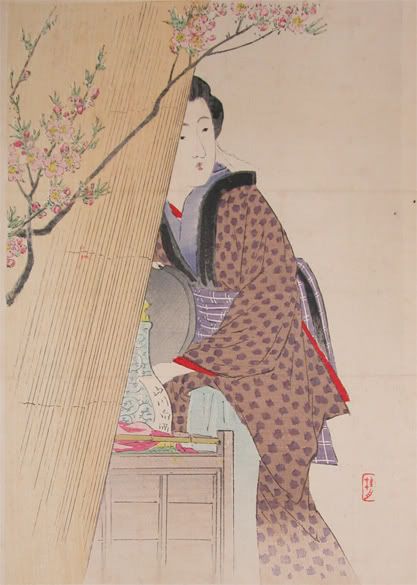


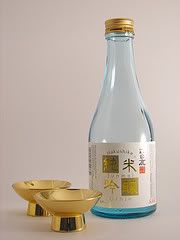
No comments:
Post a Comment